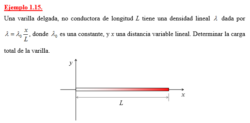Description
Problema 81. Capítulo 22 del Tipler – Mosca. Sexta Edición. Página 762.
Cuando las cargas Q y q del problema 80 son 5 μC y –5 μC, respectivamente, y el radio del anillo es 8.0 cm, la masa m oscila alrededor de su posición de equilibrio con una frecuencia angular de 21 rad/s. ¿Cuál es la masa de la partícula? Determinar la frecuencia angular de oscilación de la masa si el radio del anillo se duplica a 16 cm y todos los demás parámetros permanecen sin modificar.
The charges Q and q of Problem 80 are 5.00 μC y –5.00 μC, respectively, and the radius of the ring is 8.00 cm. When the particle is given a small displacement in the x direction, it oscillates about its equilibrium position at an angular frequency of 21 rad/s. a) What is the particle´s mass? b) What is the frequency if the radius of the ring is doubled to 16.0 cm and all other parameters remain unchanged?
Problema 80.
Un anillo de radio a que se encuentra en el plano y z posee una carga Q uniformemente distribuida en toda su longitud. En el centro del anillo se encuentra una partícula de masa m que posee una carga negativa q. b) Determine la fuerza que actúa sobre la masa m en función de x. c) Demostrar que si damos a m un pequeño desplazamiento en la dirección x, realizará un movimiento armónico simple. d) Calcular el periodo de dicho movimiento.
A stationary ring of radius a lies in the y z plane and has a uniform positive charge Q. A small particle that has mass m and a negative charge –q is located at the center of the ring. b) Find the force on the particle as a function of x. c) Show that if the particle is given a small displacement in the +x direction, it will perform simple harmonic motion. d) What is the frequency of that motion?




Reviews
There are no reviews yet.